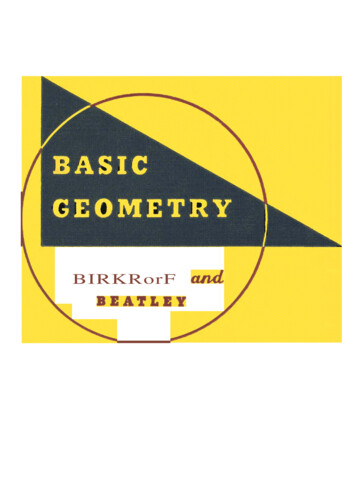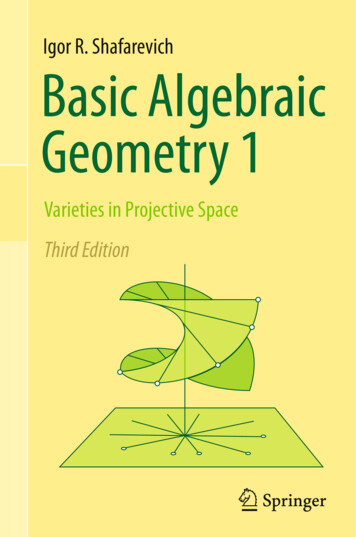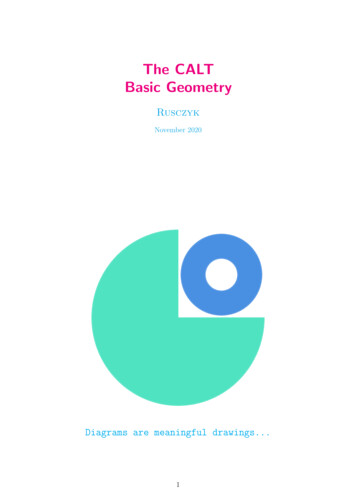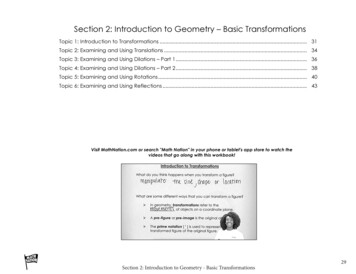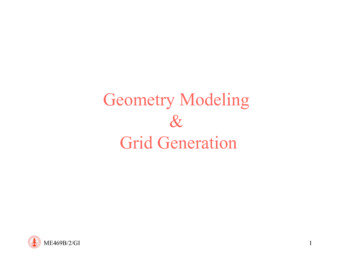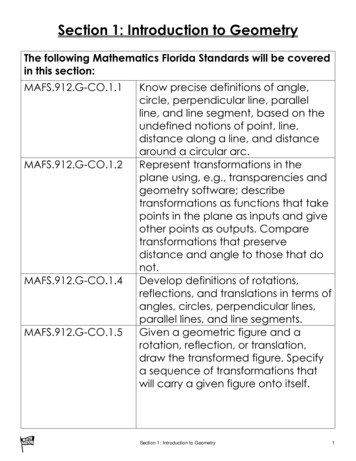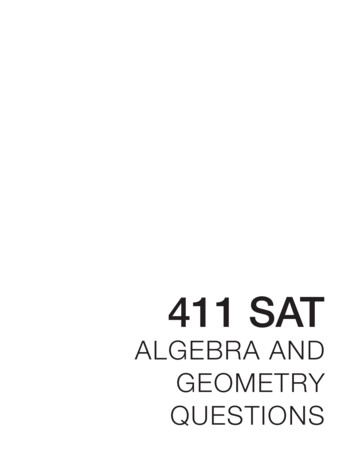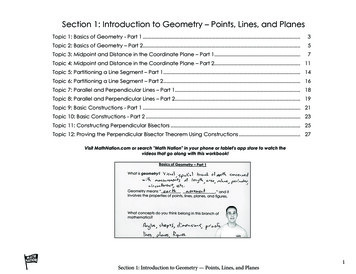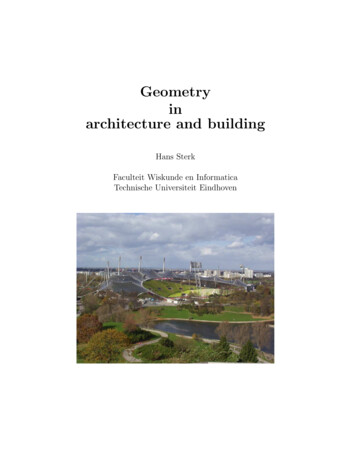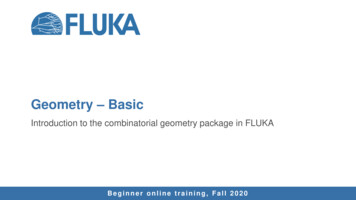
Transcription
Geometry – BasicIntroduction to the combinatorial geometry package in FLUKABeginner online training, Fall 2020
Introduction Principle of Combinatorial Geometry (CG) Basic objects called bodies (such as cylinders, spheres, parallelepipeds, etc.) are combinedto form more complex objects called regions This combination is done using Boolean operationsOperationMathFLUKAUnion Intersection Subtraction--Resulting yImage from Wikipedia (CC BY-SA 3.0)Geometry - Basicbodybody2
Introduction Combinatorial Geometry in FLUKA Originally based on the geometry package for the neutron and gamma-ray transport programMorse developed at ORNL (M.B. Emmet ORNL-4972, 1975). Many improvements have been incorporated over time, for example roto-translations ofbodies, repetition of patterns, or voxelsExample: LHC collimation insertion region built from the combination of bodies like planes, cylinders, cuboids, Geometry - Basic3
Basic concepts and terminology Four concepts are fundamental in the FLUKA CG Bodies: basic geometrical objects which are placed somewhere in the coordinate system These include: basic convex objects, plus infinite planes (half-spaces), infinite cylinders (circular andelliptical), and generic quadric surfaces (surfaces described by 2nd degree equations) Zones: sub-regions defined only via the intersection and subtraction of bodies Regions: union of zones In the simplest case a region consists of a single zone (no union operation needed in this case ) Lattices: duplication of existing objects (regions) confined in a container volume Container can be translated and rotated, multiple duplications are possibleBody #3Zone B Body #3 – Body #1Body #2Zone A Body #2 – Body #1Body #1Zone A Body #2 – Body #1Zone C Body #1PrototypeLatticeRegion Zone A Zone B Zone CGeometry - Basic4
Geometry inputHow to structure the geometry definitionGeometry - Basic5
Geometry input in FlairThe geometry input (bodies, zones/regions,lattices) is defined under the “Geometry”branch of the Input tabThe resulting geometry can be viewed underthe Geometry tabThe geometry viewer/editorwill be discussed in moredetail in tomorrowGeometry - Basic6
Structure of the geometry inputBodies are defined right after theGEOBEGIN card; the body definitionmust be terminated by an END cardThe geometry definitionmust be enclosed by theGEOBEGIN and GEOENDcardsRegions (zones) are defined after thebodies; the region definition must beterminated by an END cardLattices would be defined after theregions, right before the GEOEND card(not covered in this lecture)Note: material definition/assignments and transformationsare defined outside of GEOBEGIN-GEOENDGeometry - Basic7
The GEOBEGIN cardWill be explained later in this lecture or can be found in backupGeometry input format:This option allows choosing how thegeometry description is formatted.Default is COMBNAT, which selects anobsolete formatting style (e.g. bodiesand regions are identified via numbers)- no longer supported by Flair!Title describing thegeometry setupGeometry input/output: The geometry input/output can be readfrom/written to another file.Here the logical I/O units can bechosenBy default, output is writing to standard.out fileGeometry - BasicChoose COMBNAME, which is thename-based format and also featuresother improvements compared toCOMBNAT.8
BodiesThe basic objects of the FLUKA CGGeometry - Basic9
Body definitions A body definition in FLUKA consists of: A 3-letter code indicating the body type A unique body name (alphanumeric identifier, 8 character maximum, case sensitive) A set of geometrical quantities defining the body, e.g. the body dimensions and the positionin the coordinate system (the numbers depend on the body type, see next slides)BodiesBody type(3-letter code)Unique bodynameGeometry - BasicGeometricaldefinitionNote: all valuesare in cm!10
List of bodies Following bodies are presently available in FLUKA: Planes XYP, XZP, YZP: Infinite half space delimited by a coordinate planeNote: BOX, WED, RAW, ARB are deprecated.Do not use them, because they can causerounding problems. PLA: Generic infinite half-space, delimited by a PLAne Boxes RPP: Rectangular ParallelePiped Sphere and spheroid SPH: SPHere ELL: ELLipsoid of revolution Cylinders and cones XCC, YCC, ZCC: Infinite Circular Cylinder, parallel to coordinate axis RCC: Right Circular Cylinder XEC, YEC, ZEC: Infinite Elliptical Cylinder, parallel to coordinate axis REC: Right Elliptical Cylinder TRC: Truncated Right angle Cone Other QUA: QUAdricGeometry - Basic11
Division of space Each body splits the space into two domains: inside and outside This concept will be later used when defining zones and regions body refers to the volume inside of the body -body refers to the volume outside of the body The concept of inside and outside is applied to all bodies including infinite planesFinite bodies:Infinite (closed)bodies:Infinite planes:insideinsideoutsideinsidenormal vector(points to the outside)outsideoutsideSee next slides for detailsGeometry - Basic12
Infinite planes parallel to coordinate axes Divide space in two half spaces parallel to coordinate axesIn Flair: Three possibilities: Plane to the x-axis 3-letter code: YZP Plane to the y-axis 3-letter code: XZP Plane to the z-axis 3-letter code: XYP(note, in Flair Vx, Vy, Vz is labelled x, y, z) All defined by a single number (coordinate of the plane on the perpendicular axis): x-coordinate Vx for YZPExample XYP: y-coordinate Vy for XZP z-coordinate Vz for XYP Inside vs outside: Points for which x Vx (resp. y Vy, or z Vz) are “inside the body”insideoutside Points for which x Vx (resp. y Vy, or z Vz) are “outside the body”Geometry - Basic13
Arbitrarily orientated infinite plane Divides space in two arbitrarily oriented half spaces 3-letter code: PLA A PLA is defined by 6 numbers: Hx, Hy, Hz (vector to the plane, arbitrary length) Vx, Vy, Vz (any point lying on the plane)outside Inside vs outside: The half-space “inside the body” is that from which thevector Hx, Hy, Hz is pointing (i.e. the vector points "outside").In Flair:inside(note, in Flair Hx, Hy, Hz is labelled Nx, Ny, Nz)Geometry - Basic14
Rectangular parallelepiped Box with faces parallel to the coordinate axisoutside 3-letter code: RPP A RPP is defined by 6 numbers: Xmin, Xmax (positions of the two ZY faces of the RPP) Ymin, Ymax (positions of the two XZ faces of the RPP) Zmin, Zmax (positions of the two XY faces of the RPP) Inside vs outside: A point x, y, z is “inside the body” if it is contained inthe RPP (i.e. Xmin x Xmax and Ymin y Ymax andZmin z Zmax)In Flair:Do not use the deprecated body BOXGeometry - Basic15
Sphere Sphere at arbitrary locationoutside 3-letter code: SPH A SPH is defined by 4 numbers: Vx, Vy, Vz (origin of the sphere) R (radius of the sphere) Inside vs outside: A point x, y, z is defined as “inside the body” if it iscontained inside the sphereIn Flair:(note, in Flair Vx, Vy, Vz is labelled x, y, z)Geometry - Basic16
Right circular cylinder Finite cylinder at arbitrary position and with arbitrary orientation,limited by a cylindrical surface and two plane faces to its axis 3-letter code: RCC A RCC is defined by 7 numbers: Vx, Vy, Vz (base of the cylinder, i.e. center of one cylinder face) Hx, Hy, Hz (vector corresponding to the cylinder height, pointing to the centerof the other face) R (radius of the cylinder) Inside vs outside: A point x, y, z is defined as “inside the body” if it is contained inside thecylinderIn Flair:outside(note, in Flair Vx, Vy, Vz is labelled x, y, z)Geometry - Basic17
Infinite circular cylinders Infinite circular cylinder parallel to one of thecoordinate axis, at arbitrary positionIn Flair:(note, in Flair Ax, Ay, Az is labelled x, y, z) Three possibilities: Cylinder parallel to the x-axis 3-letter code: XCC Cylinder parallel to the y-axis 3-letter code: YCC Cylinder parallel to the z-axis 3-letter code: ZCC An XCC/YCC/ZCC is defined by 3 numbers: Ay, Az for XCC, Ax, Az for YCC, Ax, Ay for ZCC(coordinates of the cylinder axis) R (radius of the cylinder)outside Inside vs outside: A point x, y, z is defined as “inside the body” if it iscontained inside the cylinderGeometry - Basic18
Infinite elliptical cylinders Infinite elliptical cylinder parallel to one of thecoordinate axis, at arbitrary positionIn Flair:(note, in Flair Ax, Ay, Az is labelled x, y, z) Three possibilities: Cylinder parallel to the x-axis 3-letter code: XEC Cylinder parallel to the y-axis 3-letter code: YEC Cylinder parallel to the z-axis 3-letter code: ZEC An XCC/YCC/ZCC is defined by 4 numbers: Ay, Az for XCC, Ax, Az for YCC, Ax, Ay for ZCC(coordinates of the cylinder axis) Ly, Lz for XCC, Lx, Lz for YCC, Lx, Ly for ZCC (semiaxes of the cylinder)outside Inside vs outside: A point x, y, z is defined as “inside the body” if it iscontained inside the cylinderGeometry - Basic19
Arbitrary generic quadric A quadric surface defined by a 2nd degreeequation F(x,y,z) 0 3-letter code: QUA Each QUA is defined by 10 numbers: Cxx, Cyy, Czz, Cxy, Cxz, Cyz, Cx, Cy, Cz, C0corresponding to the equation:Cxx x2 Cyy y2 Czz z2 Cxy xy Cxz xz Cyz yz Cxx Cy y Cz x C0 0In Flair:Geometry - Basic20
Regions (and zones)Combining bodies to create your geometry modelGeometry - Basic21
Concept of zones and regions Regions are defined by combining FLUKA bodies using Boolean operations,more precisely: Regions are obtained by the union of sub-regions (called zones); in the simplest case aregion consists of a single zone Zones are defined by intersections and/or subtractions of bodies (Boolean zoneexpressions)Body: RCCBody: YCCZones belonging tothe same region canoverlap!!Body: RPPRegion Zone 1Zone 2On the other hand,zones belonging tothe same regionmust not necessarilybe connected.Body: PLAGeometry - Basic22
Basic principles when building geometries: Zones and hence regions must be finite Each point in space must belong to one (and only one) region Note that also the region surrounding your principal geometry must be defined (e.g. air region) Regions are of homogeneous material composition (i.e. only one material can be assignedBody: RCCto a region)Note: do not forget todefine the surroundingregionRegionBody: RPPRegionError: volume doesnot belong to anyregionBody: RPPBody: RPPRegionGeometry - BasicError: volume belongsto two regions23
Region definitions A region definition in FLUKA consists of: A unique region name (alphanumeric identifier, 8 character maximum, case sensitive, muststart with an alphabetical character) An estimate of the number of neighboring zones (see backup) A single Boolean zone expression or a series of Boolean zone expressions combined viathe union operatorUnique region nameNumber of neighboring zones (estimate)Zone 1Zone 2Zone 3RegionsExpressions can be split over multiple lines,use as many lines as needed!Geometry - BasicUnion operators forcombining zones24
Boolean zone expressions Zones are a described by a sequence of one or more bodies each beingpreceded by a or - sign (remember: /- means inside/outside a body) body: only the inner part of the body can belong to the zone (means that the zonebeing described is fully contained inside this body) -body: only the outside of the body can belong to the zone (means that the zonebeing described is fully outside this body)body3 (RPP)Zone B body1 body3( common space inside of body1 and inside of body3)body2 (RPP)body1 (RPP)Zone A body2 –body1( space inside of body2 and outside of body1)Geometry - Basic25
Parenthesis in region definitions Parentheses can be used to perform complex Boolean operations in thedescription of regions In evaluating the expressions, the highest operator precedence is given toparentheses, followed by , - and the operator Still, the extensive use of parenthesis is discouraged and can create unreadableand inefficient code It is perfectly possible to implement (complex) geometries without using parenthesis In case you use parentheses, pay attention to the respective parameters on theGEOBEGIN card (optimization level and runtime evaluation of parenthesis) See backup for detailsGeometry - Basic26
Special region: the outer black hole confinement FLUKA defines a special material calledBLCKHOLE:Outer sphereOuter BLCKHOLE region BLCKHOLE is an all-absorbing material Particles vanish when entering a region filledwith BLCKHOLESimulation geometry The entire geometry must be embeddedin a region filled with BLCKHOLE This avoids tracking particles to infinity The outer surface of this BLCKHOLE regionmust be a single closed body (e.g. a sphere)Outside of the BLCKHOLE enclosure,the region can remain undefined!Geometry - Basic27
Tracking accuracy The tracking accuracy parameter can be adjusted on the GEOBEGIN card Defines absolute accuracy used for tracking and boundary identification (in units of 10-6 cm) Should be larger than Ar*L , where: L is the largest coordinate value in the geometry (without BLCKHOLE confinement) Ar is the relative accuracy achievable in double precision ( 10-14-10-15). By default, FLUKA tries to guess the parameter based on the second biggest body in yourgeometry (assuming the biggest one is the BLCKHOLE confinement) Can be overwritten by explicitly setting the parameter on GEOBEGINGeometry - Basic28
Tracking speed Number of bodies per zone: If the number of bodies per zone definition becomes large this slows down the tracking Rather segment in more zones than using too many bodies per zone (rule of thumb: not morethan 10 bodies per zone definition) Overlapping zones (for the same regions) can even be beneficial since particles may remainlonger in o
Geometry - Basic Example: LHC collimation insertion region built from the combination of bodies like planes, cylinders, cuboids, 3. Basic concepts and terminology Four concepts are fundamental in the FLUKA CG Bodies: basic geometrical objects which are placed somewhere in the coordinate system These include: basic convex objects, plus . infinite planes (half-spaces), infinite .
